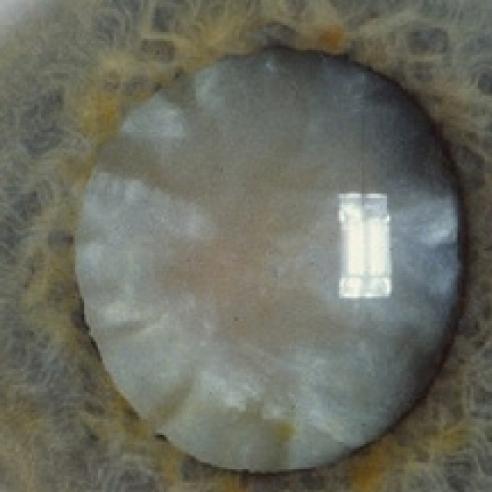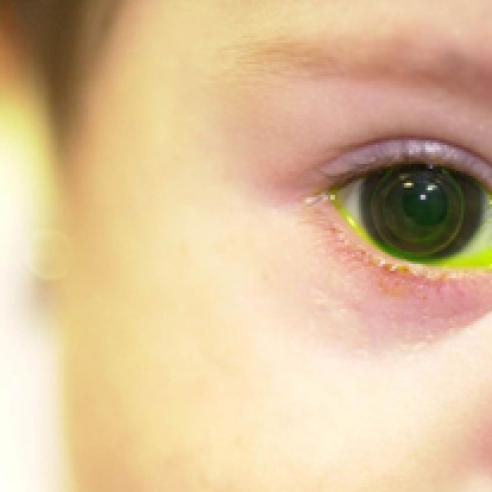New research sheds light on how UV rays may contribute to cataract

An age-related cataract.
A new study offers an explanation for how years of chronic sunlight exposure can increase the risk of cataract, a clouding of the eye lens that typically occurs with aging. The study firms up a link between the sun's damaging rays and a process called oxidative stress. It was funded in part by RPB and in part by the National Eye Institute (NEI).
It's well known that exposure to ultraviolet (UV) light from the sun can cause skin damage. But many studies show that UV light can also increase the risk of cataract and other eye conditions.
Oxidative stress refers to harmful chemical reactions that can occur when our cells consume oxygen and other fuels to produce energy. It's an unfortunate consequence of living, but it's also considered a major contributor to normal aging and age-related diseases-including cataract formation in the lens.
The cells within the lens contain mostly water and proteins, and lack the organelles (literally "tiny organs") typically found in other cells. This unusual make-up of lens cells renders the lens transparent, uniquely capable of transmitting light and focusing it on the retina at the back of the eye. When a cataract forms, the proteins inside lens cells show signs of oxidative damage, and they ultimately become clumped together, scattering light rather than transmitting it. So, the theory goes, oxidative stress (or something like it) is responsible for destroying the neatly ordered proteins inside the lens and producing a cataract.
The theory might sound simple, but there is a puzzling fact that doesn't fit: The oldest cells in the lens are not only devoid of the organelles that keep most other cells alive and functioning, they also get little to no oxygen. So how can they suffer from oxidative stress?
The new study, led by researchers at Case Western Reserve University in Cleveland, Ohio, suggests that UV light may provide an answer. The study shows that UV light can damage lens proteins in a distinct way (called glycation) that is typically seen in cataract and in cells damaged by oxidative stress. In other words, UV light can substitute for oxygen to trigger harmful oxidative reactions in the lens.
Prior studies have supported this theory. But the Case Western team has unveiled a detailed play-by-play of the chemical changes induced in the lens by UV light.
Many clinical studies, including an NEI-funded study of fishermen in the Chesapeake Bay, have pointed to UV light exposure as a risk factor for age-related cataract. UV light rays are invisible and have shorter wavelengths than visible light. In the earth's atmosphere, UV light comes in two varieties: UVA and UVB. Their relative contributions to cataract remain unclear, but UVA penetrates more deeply into the body and may be more likely to reach the lens. NEI's National Eye Health Education Partnership (NEHEP) recommends wearing sunglasses with both UVA and UVB protection to shield your eyes from the sun. A hat can help, too.
"UV light has long been suspected to have a role in cataract formation, but the mechanism has not been clear," said Ram Nagaraj, PhD, the study's senior author and a professor of ophthalmology and visual sciences at Case Western.
Dr. Nagaraj and his colleagues tested the effects of UVA light on proteins and chemicals found in lens cells. They found that in the absence of oxygen, UVA light can trigger a chain reaction that begins with amino acid derivatives called kynurenines, and ends with protein glycation in the lens. In earlier work, they also showed that mice genetically engineered to over-produce kynurenines develop cataract by 3 months of age. In the current study, when lenses from these mice were exposed to 2 hours of intense UVA light, they accumulated damaged (glycated) proteins.
"Our study shows how UV light could promote cataract development, and reiterates the importance of wearing sunglasses to protect your eyes the sun's harmful rays," Dr. Nagaraj said.
Unfortunately, the researchers found that a natural antioxidant in the eye and other tissues, called glutathione, offered little protection against the damaging effects of UV light. Several clinical studies have tested the potential for antioxidant supplements to prevent or slow age-related cataract, with mixed results.
Overall, there is a need to better understand the extent to which natural antioxidants or other mechanisms within the lens might offer some protection against the sun, said Houmam Araj, PhD, who oversees programs on lens, cataract and oculomotor systems at NEI. One such mechanism includes proteins called chaperones, which can help prevent damaged proteins from clumping together.
With further support from RPB, Dr. Nagaraj is exploring chaperones as therapeutic agents to inhibit cataract formation.
"When do these mechanisms work in the lens and when do they fail? Answering those questions might lead to drug treatments for preventing cataract, and perhaps even skin cancer," Dr. Araj said. "The eye and lens provide a useful, accessible system to study general countermeasures the body might have for defending itself against UV radiation."
The current study was done in collaboration with the Iladevi Cataract and IOL Research Center in Ahmedabad, India. It was funded by NEI (grants EY022061, EY023286, EY011373 and EY007099), Research to Prevent Blindness and the Ohio Lions Eye Research Foundation.
Reference:
Linetsky M, Raghavan CT et al. "UVA light-excited kynurenines oxidize ascorbate and modify lens proteins through the formation of advanced glycation end products: implications for human lens aging and cataract formation." Journal of Biological Chemistry, May 2014. DOI: 10.1074/jbc.M114.554410.
June 4, 2014
Related News: Cataract

Stem Cells Regenerate Human Lens After Cataract Surgery In Children
A new approach to removing congenital cataracts in infants allows remaining stem cells to regrow functional lenses.

A Career Retooled
Dr. David Beebe's studies of the vitreous body - the gel that fills the eye - are aimed at identifying the mechanism responsible for age-related nuclear cataracts and open angle glaucoma.

Eye Drops Could Clear Up Cataracts Using Newly Identified Chemical
RPB-supported researchers have partially reversed cataracts in dogs using eye drops and injections of a naturally occurring steroid in the human body.

Contacts better than permanent lenses for babies after cataract surgery
For adults and children who undergo cataract surgery, implantation of an artificial lens is the standard of care. But a clinical trial, funded jointly by RPB and the National Eye Institute, suggests that for most...

Healthy Diet May Reduce Cataracts in Women
Women who eat foods rich in a variety of vitamins and minerals appear to have a lower risk of developing cataracts, according to a large population study.Read the press release.Read the article.Read the abstract.
Subscribe
Get our email updates filled with the latest news from our researchers about preventing vision loss, treating eye disease and even restoring sight. Unsubscribe at any time. Under our privacy policy, we'll never share your contact information with a third party.
| General Info | Grants | News & Resources |




